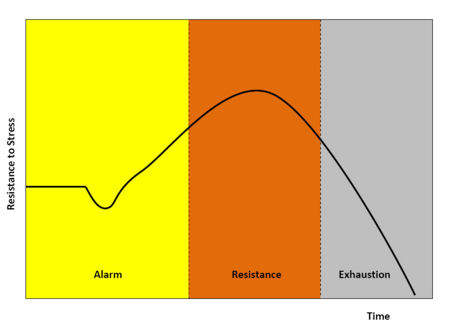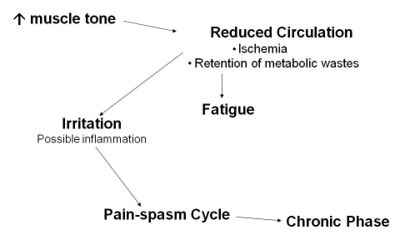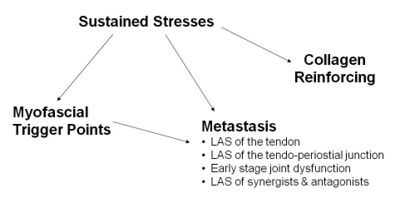Local Adaptation Syndrome (Chaitow, 2000; Chaitow, 2006)
Contents
Contributors
David McQuillan (2008). Otago Polytechnic: Massage Therapy
Muscular Adaptation
Many different factors may contribute to an increase in muscular tone.
- Stress response
- Emotional distress
- Postural distortions
- Repetitive physical activities (sports, occupation, hobbies, etc.)
- Trauma
- Structural factors (e.g. leg-length difference)
- Visceral & other reflex activity
The first two items on this list cause a body-wide increase in muscular tone as part of the alarm stage of Hans Seyle’s General Adaption Syndrome (GAS).
The remaining items on the list (postural distortions, repetitive physical activities, trauma, structural factors, and reflex activitiy) tend to cause an increase in muscular tone in locally affected structures. Selye's model of a systemic reaction to stress can be scaled down to the local level (e.g. single muscle, joint, etc.). Chaitow (2000) has described this as Local Adaption Syndrome (LAS), and relates the stages of LAS to the stages of General Adaption Syndrome. It's also useful to relate this condition to the ideas of acute and chronic pathology, as this is the language more commonly used to describe soft-tissue conditions. Accordingly the following discussion will relate to the alarm, resistance, and exhaustion phases, but the headings will categorise the stages as Acute and Chronic.
Acute local adaptation
In the Alarm Phase, the body reacts to a local stressor (e.g. postural distortions, repetitive physical activities, trauma, leg-length difference, reflex activity) with an increase in local muscular tone.
When local muscular tone is increased for any length of time, the affected tissues suffer from
- Local ischaemia due to increased muscular tone and demand
- Restricted elimination leading to the retention of metabolic wastes
This may be considered the beginning of the Adaption/Resistance Phase (although Leon Chaitow considers this to be the second half of the Alarm phase).
The combination of ischaemia and retention of metabolites leads over time to fatigue then irritation, and may cause inflammation. The pain and discomfort that are likely to arise can lead to further increases in tone and pain via the Pain-Spasm cycle.
Palpation at this time would show tissues to be warmer than other tissues. The tissues could be oedematous, and would usually be very sensitive.
Chronic local adaptation
If the adaption phase lasts longer than a few weeks, the sustained stresses stimulate the production of collagen. The body uses this collagen to lay down bands of fibrous tissue in support of the hypertonic muscle. This point could be considered the transition from an acute condition to a chronic condition.
Ischaemia, lack of oxygen and the retention of metabolites continue to increase, and myofascial trigger points begin to develop. At this point taut bands are palpable in the local muscle tissues, and satellite trigger points begin to develop.
The effects of increased muscular tone also begin to be felt at the muscles tendonous insertions. This increased tone may lead to
- LAS of the tendon OR
- LAS of the tendo-periostial junction OR
- Early stage joint dysfunction
When the body’s adaptive capacities are exhausted (which may take many years), the exhaustion or collapse stage sets in. This may be characterized by arthritic joint changes or chronic muscular/soft-tissue dysfunction.
The progression of tissue changes in an individual body through these three stages depends on age, exercise, and nutritional status among other things.
An example
Following is an excellent example of Local Adaption Syndrome of the Shoulder taken from Chaitow's article Local Adaptation Syndromes Wholistic Solutions Depend on Contextual Thinking (2006)
“Take someone whose posture involves carrying the head forward of its center of gravity, with shoulder protracted, so altering the position of each glenoid fossae in relation to the humerus, creating difficulties for the rotator cuff group of muscles. There also might be thoracic and/or cervical spinal restrictions, as well as overuse factor. Symptoms therefore might have evolved over time, as adaptation to the imposed demands have gradually exhausted the elastic and dynamic self-repair potential of the soft tissues (muscles, ligaments, capsules, etc.) involved.
We know the anterior glenohumeral capsule is structurally stronger than the posterior joint capsule, although functionally it's commonly exposed to greater cumulative trauma – particularly in those who use their arms in an overhead position (pitchers, racket sports players, volleyball players, painters and decorators, window cleaners). The tissues of anterior joint capsule will undergo creep, becoming unstable and inflamed and commonly, in due time, restricted in flexion.
This can be described in terms of the local adaptation syndrome as follows:
- An acute (alarm) phase would follow initial stress (perhaps excessive throwing action).
- During this phase, repair activity would be carried out, almost certainly involving some inflammation and discomfort.
- Compensatory recruitment patterns would be used to minimize stress on the anterior capsule region; other muscles would be called on to work inappropriately, creating new stress patterns.
- A combination of repetitive microtrauma due to continued throwing activity, overlaid on a modified recruitment pattern, possibly overlaid on long-term postural stressors (forward head position, inhibited lower fixators of the scapula, excessive activity of some of the rotator cuff muscles, etc.), and evolution of myofascial trigger points, together with possible nutritional imbalances may then lead to a situation where the damage rate exceeds the repair rate.
- Pain and greater restriction of movement become the dominant symptoms, leading to underuse of the arm, psychological distress, and further compensation/adaptation demands on other tissues and structures.
- Thus, wear and tear eventually produces a stage of virtual decompensation – the final phase of the local adaptation syndrome – a possible "frozen shoulder" scenario.
- The potential for further adaptation in that shoulder to the imposed demands would have been exhausted, and other adaptations (involving overuse of the unaffected shoulder and more widespread postural changes) might become increasingly evident.
Action
So, what's to be done when this patient calls on your help? Solutions to such situations do not lie in local treatment of the painful and restricted area (anterior capsular strain), where little more than symptomatic short-term relief would be possible (for example, use of ice and lymphatic drainage). For the manual therapist to attempt to locally mobilise the glenohumeral joint into greater ease in flexion, without understanding the biomechanical rationale for the original local stress to the anterior glenohumeral capsule, would be both futile and probably harmful.
Wholsitic thinking suggests there should be attention to the larger picture, including whole-body postural considerations, potential thoracic spinal restrictions and improved use patterns – as well as normalization, if possible, of the shortened and inhibited muscles and other soft tissues – including deactivation of trigger points and mobilization of the shoulder joint. In this broader clinical approach, consideration also would be given to nutritional features as well as to rehabilitation, including aspects of pain behaviour and altered patterns of use resulting from the condition.
Therapeutically, it is important to incorporate appropriately focussed use patterns into a rehabilitation process, building on the re-education and retraining potential of imposed demand.”
References
Chaitow, L. (2000). Palpation Skills – Assessment and Diagnosis Through Touch. London: Harcourt Publishers Limited.
Chaitow, L. (2006). Local Adaptation Syndromes Wholistic Solutions Depend on Contextual Thinking. Sourced from http://www.massagetoday.com/mpacms/mt/article.php?id=13363
McQuillan, D. (2008a). General Adaptation Syndrome. Retrieved August 1, 2008 from http://www.wikieducator.org/Image:General_Adaptation_Syndrome.jpg
McQuillan, D. (2008b). Local Adaptation Syndrome - Acute phase. Retrieved August 1, 2008 from http://www.wikieducator.org/Image:LAS_acute.jpg.
McQuillan, D. (2008c). Local Adaptation Syndrome - Chronic phase. Retrieved August 1, 2008 from http://www.wikieducator.org/Image:LAS_chronic.jpg


